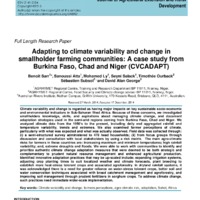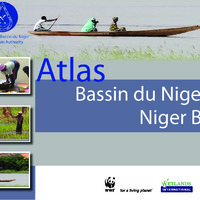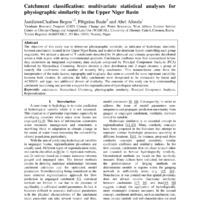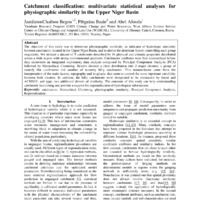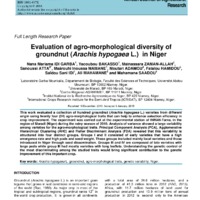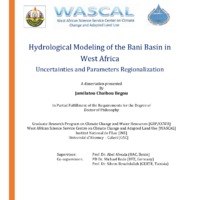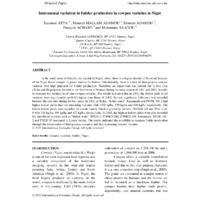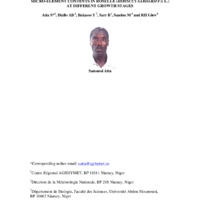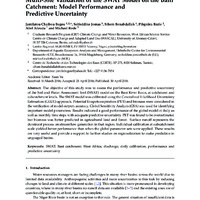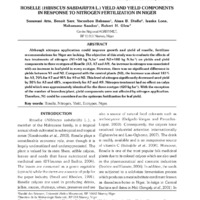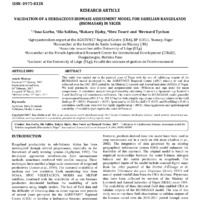Recherche
16 items
Adapting to climate variability and change in smallholder farming communities: a case study from Burkina faso, Chad and Niger
Climate variability and change is regarded as having major impacts on key sustainable socio-economic and environmental indicators in Sub-Saharan West Africa. Because of these concerns, we investigated smallholders knowledge, skills, and aspirations about managing climate change, and document adaptation strategies used in the semi-arid regions coming from Burkina Faso, Chad and Niger. We analyzed climate data from the 1950’s to the present, including daily and aggregated rainfall and temperature variability, trends and extremes.
Atlas du bassin du niger
Cet ouvrage est consacré au Niger, le fleuve des fleuves. Ce cours d’eau traverse quatre pays mais son bassin draine neuf (9) Etats d’Afrique de l’Ouest représentant un kaléidoscope de cultures et de paysages. Son nom original, «egerou n-igereou», signifie «fleuve des fleuves». Il lui a été donné par les Touaregs, qui voulurent ainsi souligner le caractère exceptionnel qu’avait pour eux ce cours d’eau. Le fleuve Niger est le 4ème bassin hydrographique d’Afrique avec ses 4.200 km de long et dont le bassin couvre environ 2,1 millions de km2 de superficie totale pour 1,5 millions de km2 de bassin actif. La gestion intégrée de ce potentiel hydrique et de ses écosystèmes associés est un enjeu majeur pour les Etats membres de l’Autorité du Bassin du Niger (ABN) et ses partenaires comme l’attestent les différentes thématiques abordées dans cet ouvrage. Nous sommes aujourd’hui tous conscients des priorités de développement du bassin et j’en suis convaincu que cet ouvrage contribuera à faire mieux connaître le bassin du Niger dans toute sa diversité aux plans tant national qu’international, et servira d’inspiration pour atteindre les objectifs de la Vision partagée. Enfin, cette publication est le témoignage d’une collaboration fructueuse entre l’ABN et deux ONG Internationales partenaires, le Fonds Mondial pour la Nature (WWF) à travers son Programme Eaux douces pour l’Afrique de l’Ouest et Wetlands International.
Catchment classification: multivariate statistical analyses for physiographic similarity in the upper niger basin
The objective of this study was to determine physiographic similarity, as indicator of hydrologic similarity between catchments located in the Upper Niger Basin, and to derive the dominant factors controlling each group singularity. We utilized a dataset of 9 catchments described by 16 physical and climatic properties distributed across a wide region with strong environmental gradients. Catchments attributes were first standardized before they underwent an integrated exploratory data analysis composed by Principal Component Analysis (PCA) followed by Hierarchical Clustering. Results showed a clear distribution into 2 major clusters: a group of easterly flat catchments and another of westerly hilly catchments. This nomenclature came from the interpretation of the main factors, topography and longitude, that seem to control the most important variability between both clusters. In addition, the hilly catchments were designated to be dominated by forest and ACRISOL soil type, two additional drivers of similarity. The outcome of this study can help understanding catchment functioning and provide a support for regionalization of hydrological information.
Catchments classification: multivariate statistical analysis for physiographic similarity in the niger basin
The Bani basin was classified into 4 clusters of similar catchments (Figures 2-4), The topographic variables (Elev, ElevMin, ElevMax, Slo1), precipitation and the geographical position of the sub-catchment (Lat) were demonstrated to be the most important causes of similarity between catchments belonging to Cluster 2 and Cluster 4 (Table 2), This study permitted to propose the two nomenclature: Group of northerly flat and semi-arid catchments, and group of southerly hilly and humid catchments.
Estimates of Phenotypic and Genotypic Variance and Heritability in Eighty Nine Bambara Groundnut Vigna subterranea (L.) Verdcourt] Accessions Collected from Six Regions of Niger
The bambara groundnut [Vigna subterranea (L.) Verdc. (Fabaceae)] is a legume mainly cultivated by women, for the nutritional quality of these seeds. It is a so-called minor culture and the improvement of the plant and its popularization remains to be promoted. The objective of this present work is to evaluate the genetic variability of bambara groundnut accessions. The experiment was carried out according to a completely randomized block device with four replications. Twenty-two (22) characters including four (4) phenological, four (4) morphological and fourteen (14) related to yield were evaluated for accessions characterization. Descriptive analysis showed significant differences. The coefficients of variation ranged from 3.51% (maturity date) to 38.87% (shell weight). Significantly high values (CV˃20%) for 8 of the metric parameters were observed. Pod weight per plant and seed weight per plant (r=0.943), yield in kg/ha (r=0.943); seed weight per plant and yield in kg/ha (r=0.999) showed the strongest correlations. The phenotypic and genotypic coefficients of variation were high for dry biomass weight (PCV=42.23%; GCV=28.40%), shell weight (PCV=63.46%; GCV=22.46%) and 100-seed weight (PCV=25.57%; GCV=25.25%). Maturity date (95.77%) and 100-seed weight (99.84%) had high heritabilities. Broad-sense heritability and genetic gain are high for 100-seed weight (H2=99.84%; GA=52.58%). The Ascending hierarchical classification produced four groups of which group 4 is the most efficient in yield with short (20.58cm) early accessions (80.32 days). Groups 1 and 2 include, late accessions (~22cm) with respectively maturity dates (DM=85.67 days and DM=86.53 days.
Evaluation of agro-morphological diversity of groundnut (Arachis hypogaea L.) in Niger
This work evaluated a collection of hundred groundnut (Arachis hypogaea L.) varieties from different origin using twenty four (24) agro-morphological traits that can help to enhance selection efficiency in crop improvement. The experiment was carried out at the experimental station of INRAN-Tarna, in the region of Maradi (Niger) during the rainy season of 2010. Analysis of variance showed a large variability among varieties for the agro-morphological traits. Principal Component Analysis (PCA), Agglomerative Hierarchical Clustering (AHC) and Fisher Discriminant Analysis (FDA) revealed that this variability is structured into four distinct groups. Groups I and II consisted of early varieties that have a high emergence rate and high pods and seed weight. These groups included mainly local varieties and those introduced in Niger through seed dissemination. Groups III and IV are composed of late varieties with large pods while group III had mostly varieties with long leaflets. Understanding the genetic control of the most discriminating among the studied traits would bring significant contribution to the genetic improvement of this important crop.
Evaluation of the Impact of Seasonal Agroclimatic Information Used for EarlyWarning and Farmer Communities’ Vulnerability Reduction in Southwestern Niger
Abstract: In Niger (a fully Sahelian country), the use of climate information is one of the early warning strategies (EWSs) for reducing socio-economic vulnerabilities in farmer communities. It helps farmers to better anticipate risks and choose timely alternative options that can allow them to generate more profit. This study assesses the impacts of the use of climate information and services that benefit end-users. Individual surveys and focus groups were conducted with a sample of 368 people in eight communes in Southwestern Niger. The survey was conducted within the framework of the
ANADIA project implemented by the National Meteorological Direction (NMD) of Niger. The survey aims to identify different types of climate services received by communities and evaluates the major benefits gained from their use. Mostly, the communities received climate (73.6%) and weather (99%) information on rainfall, temperature, dust, wind, clouds, and air humidity. Few producers in the area (10%) received information on seasonal forecasts of the agrometeorological characteristics of the rainy season. The information is not widely disseminated in the villages during the roving seminars conducted by the NMD. For most people, this information is highly relevant to their needs because of its practical advice for options to be deployed to mitigate disasters for agriculture, livestock, health, water resources, and food security. In those communities, 82% of farmers have (at least once) changed their routine practices as a result of the advice and awareness received according to the climate
information. The information received enables farmers (64.4%) to adjust their investments according to the profile of the upcoming rainfall season. The use of climate information and related advice led to an increase of about 64 bunches (equivalent to 10 bags of 100 kg) in annual millet production, representing an income increase of about 73,000 FCFA from an average farmland of 3 ha per farmer. In addition, the use of climate information helps to reduce the risks of floods and droughts, which often cause massive losses to crop production, animal and human life, infrastructure, materials, and goods. It has also enabled communities to effectively manage seeds and animal foods and to plan
social events, departures and returns to rural exodus. These analyses confirm that the use of climate information serves as an EWS that contributes to increasing the resilience of local populations in the Sahel.
Hydrological modeling of the bani basin in west africa
De nombreux bassins de drainage à travers le monde ne disposent d’aucune mesure de débit. Les méthodes de régionalisation sont alors généralement utilisées pour les prévisions en bassins non jaugés. L'objectif principal de cette étude est de prévoir les hydrogrammes d’écoulement dans le bassin du Bani afin de contribuer à l’amélioration de la connaissance sur la disponibilité des ressources en eau. Tout d'abord, le modèle hydrologique SWAT a été calibré sur de nombreux bassins jaugés sur la période de 1983-1992 et validé sur la période 1993-1997 en utilisant la méthode « Generalized Likelihood Uncertainty Estimation (GLUE) ». Ensuite, des groupes de bassins similaires ont été déterminés en fonction de leurs caractéristiques physiographiques et climatiques et au moyen d’une analyse statistique multivariée. Deux méthodes de régionalisation basées sur le concept de similarité entre bassins, ont été utilisées : la similarité physique et la proximité spatiale. Dans les deux cas, le jeu de paramètres calés du modèle est entièrement transféré du bassin jaugé vers le bassin non jaugé pour y simuler l’hydrogramme de débits journaliers de la période 1983-1997. Les résultats indiquent une bonne performance du modèle à l’échelle journalière et mensuelle, ainsi qu’à l’échelle du bassin et des sous-basins. La performance du modèle à l’échelle du bassin global et sur un pas de temps journalier est caractérisée par un critère de Nash de 0.76 et 0.84 et un coefficient de détermination de R2 de 0.79 et 0.87 en période de calibration et de validation, respectivement. Aussi, les valeurs absolues du PBIAIS demeurent inferieures à 25&, ce qui témoigne d’une bonne prévision du bilan d’eau. Il est à noter que les incertitudes associées demeurent satisfaisantes malgré les conditions de données limitées qui sous-tendent cette modélisation. Ainsi, 61& des débits observés (P-factor = 0.61) sont compris à l’intérieur de la bande d’incertitude dont la largeur reste adéquate (R-factor = 0.91). La calibration mensuelle a quant à elle permit d’atteindre une meilleure performance du modèle et une diminution des incertitudes à l’exception du bilan d’eau dont les erreurs de prévision semblent avoir augmenté. La calibration a également permis d'identifier 12 paramètres du modèle qui simulent au mieux les débits observés. Les bassins étudiés ont été classes en trois groupes: un groupe de bassins de plaine, semi-arides et situés au Nord, un autre groupe de bassins d’altitude qu’on rencontre dans les zones humides du Sud, et un troisième groupe situé dans le centre du bassin d'étude, à l'intérieur duquel, aucun des descripteurs semble se démarquer significativement des autres. Dans l'ensemble, la régionalisation a donné de bons résultats au niveau de plusieurs bassins cibles. Les meilleurs ont toutefois été enregistrés dans la zone aride et à l’exutoire global du bassin, particulièrement. Cependant, on note également une augmentation des incertitudes précisément dans cette zone. Une bonne similarité hydrologique mutuelle a été mise en évidence entre certains bassins, dont le meilleur indicateur reste la proximité spatiale. La connaissance de la disponibilité des ressources en eaux, particulièrement au niveau des bassins non jauges, est d’une utilité capitale dans plusieurs domaines d’application telles que l'allocation de l'eau pour la consommation et pour l'irrigation surtout en Afrique de l'Ouest qui fait face fréquemment à la gestion des risques liés au déficit en eau et a l'insécurité alimentaire en raison des impacts du changement climatique. Ces résultats contribuent également à une meilleure compréhension du fonctionnement hydrologique d’une zone jusque-là non explorée dans le domaine de la prévision en bassins non jaugés (PUB), et constituent une première étape vers de nouvelles investigations qui contribueront à l’amélioration des prévisions de l’information hydrologique.
Identification of the swat model parameters on the bani catchment (west africa) under limited data condition
Results showed that the model performance can be judged as very good (Moriasi et al., 2007) especially considering limited data condition and high climate, land use and soil type variabilities in the studied basin (Figure 1). Prediction uncertainty is acceptable: most of the observed data (around 80& ) are bracketed by the 95PPU within an acceptable width (R-factor < 1). However, model is characterized by more prediction uncertainties during high flows (Figure 2). The most sensitive parameters are mostly related to surface runoff reflecting the dominance of this process on the streamflow generation (Table 1).
Interannual variation in fodder production in cowpea varieties in Niger
In the south areas of Niamey, the capital of Niger, where there is a higher density of livestock because of the Niger River, cowpea is grown mainly for fodder. Unfortunately, there is a lack of dual-purpose cowpea varieties with high potential for fodder production. Therefore, an experiment was carried out in two sites (Ticko and Bogodjotou) located in the Southwest of Niamey during the rainy season of 2001 and 2002, in order to compare the production of nine cowpea varieties. The results indicated that in 2001, the fodder yield of all varieties were significantly (p<0.01) higher than those of 2002. But not significant difference was recorded between the two sites during the two years. In 2001, at Ticko, “Baban waké", Kanannado and IT93K-398-2 had higher fodder yields than the remaining varieties with 1032 kg/ha, 879 kg/ha and 866 kg/ha respectively. The lowest fodder yields were recorded for Locale variety which is grown by farmers, IT89KD-349 and TVu 1234- 9 with 715 kg/ha, 499 kg/ha and 677 kg/ha, respectively. In 2002, the highest fodder yields were also recorded for introduced varieties such as “Baban waké", IN92E-3, IT89KD-288, IT89KD-349, Kanannado, IT93K-398- 2 and TN256-87 compared to Locale variety. The results indicated the possibility to increase fodder production through the introduction of dual-purpose cowpeas and thus increasing farmers’ income. © 2011 International Formulae Group. All rights reserved.
MICRO-ELEMENT CONTENTS IN ROSELLE (HIBISCUS SABDARIFFA L.) AT DIFFERENT GROWTH STAGES
In the western Sahel, leaves of Roselle (Hibiscus sabdariffa) have considerable economic importance because of their nutritional and medical uses. These plant organs are used to supplement nutrients provided by cereals such as millet and sorghum. However, there is a lack of information on the nutrient composition of these plant organs of Roselle at different growth stages. Therefore, the experiment was carried out under rainfall conditions during the 2006 rainy season (from July to September) at the experimental station of the Agrhymet Regional Centre in Niamey (Niger). The content of the micronutrients Fe, Mn, Cu and Zn in leaves of three ecotypes of Roselle (A3, A7 and A9) at three growth stages, vegetative (stage I), flowering (stage II), and mature (stage III) was determined. The experimental design was a randomized complete block with four replicates and one variable (ecotype). Results indicated that at stage I, ecotype A3 had higher Fe content in leaves. In addition, A3 had also the highest Zn content in leaves at stage I. For all three ecotypes, Fe and Zn content in the leaves decreased significantly (p<0.05) from stage I to stage II, then remained constant until stage III. For Fe, the decrease between stage I and II was 37& for A3 and 50&, respectively for A7 and A9. The corresponding decrease of Zn content was 30& for A7 and 50&, respectively, for A3 and A9. The Mn content in the leaves of Roselle was similar for the three ecotypes at stage I, thereafter increased continuously during plant growth. From stage I to II, the increase was about 90&, 70& and 50&, respectively for A9, A7 and A3. From stage II to III, the increase in Mn content in the leaves was significantly (p<0.05) higher for A3 and A7, respectively 180& and 80&. At stages I and II, the highest Cu content was recorded for A3 and the lowest one for A7. During the whole cycle of plant growth, the Cu content in the leaves was relatively constant for A9. In contrast, Cu content in the leaves decreased for the remaining ecotypes. Therefore the vegetative stage corresponding to 25 days after sowing is the recommended optimal harvest time of Roselle to maximise on the nutrients.
Multi-site validation of the swat model on the bani catchment: model performance and predictive uncertainty
The objective of this study was to assess the performance and predictive uncertainty of the Soil and Water Assessment Tool (SWAT) model on the Bani River Basin, at catchment and subcatchment levels. The SWAT model was calibrated using the Generalized Likelihood Uncertainty Estimation (GLUE) approach. Potential Evapotranspiration (PET) and biomass were considered in theverificationofmodeloutputsaccuracy. GlobalSensitivityAnalysis(GSA)wasusedforidentifying important model parameters. Results indicated a good performance of the global model at daily as well as monthly time steps with adequate predictive uncertainty. PET was found to be overestimated but biomass was better predicted in agricultural land and forest. Surface runoff represents the dominant process on streamflow generation in that region. Individual calibration at subcatchment scale yielded better performance than when the global parameter sets were applied. These results are very useful and provide a support to further studies on regionalization to make prediction in ungauged basins.
Performance of similarity analysis in the estimation of forage yields in the Sahelian zone of Niger
The study aims to test the performance of similarity analysis in herbaceous fodder biomass estimate in the Nigerian pastoral zone, in a context of insecurity and precipitation spatiotemporal variability. It is carried out on the time series of NDVI decadal images of SPOT VEGETATION for the period from 2001 to 2012 and on fodder biomasses measured in situ during the same period. Similarity analysis compares NDVI seasonal patterns to detect similar years using three criteria: the RMSE (Root Mean squared error), the MAD (Mean absolute Deviation), and R². Exploratory statistical analyzes with bootstrap are carried out to better characterize the observations resulting from the simulation. Moreover, the analysis of the parametric and non-parametric correlations is carried out to evaluate the level of link between the simulated data and the real data. The t test and the Wilcoxon test are then carried out in order to compare the means of the actual biomasses with those obtained by the similarity analysis. At the local level, the results indicate that the R² is more efficient than the RMSE and the MAD which have almost the same performances. The results of the similarity calculated with R² can be used as a proxy to the herbaceous phytomass measured in situ, as there is no significant difference between the simulated mean and the mean measured at the 1% threshold. On the other hand, the results of the similarity calculated with the RMSE and the MAD are not exploitable. Parametric and nonparametric correlations are all significant at the 1% threshold. However, the R² are low and vary between 0.32 and 0.45. It therefore seems necessary to continue the research, as numerous studies have revealed very good links between certain indices like the FAPAR, the EVI and the LAI and the aerial phytomasse.
ROSELLE (HIBISCUS SABDARIFFA L.) YIELD AND YIELD COMPONENTS IN RESPONSE TO NITROGEN FERTILIZATION IN NIGER
Although nitrogen application could improve growth and yield of roselle, fertilizer recommendations for Niger are lacking. The objective of this study was to evaluate the effects of two treatments of nitrogen (N1=50 kg N,ha-1 and N2=100 kg N.ha-1) on yields and yield components in three ecotypes of Roselle (A3, A7 and A9). An increase in nitrogen was associated with an increase in leaf yield in every ecotype. However, there was no significant difference in yields between N1 and N2. Compared with the control plants (N0), the increase was about 181& for A3, 70& for A7 and 95& for A9 at N2. This level of nitrogen significantly decreased seed yield by 30& for A3 and 48&, respectively for A7 and A9. Nitrogen treatment had no effect on calyx yield which was approximately identical for the three ecotype (420 kg ha-1). With the exception of the number of branches/plant, yield components were not affected by nitrogen application. Therefore, N1 could be considered as the optimum fertilization for leaf yield.
VALIDATION OF A HERBACEOUS BIOMASS ASSESSMENT MODEL FOR SAHELIAN RANGELANDS (BIOMASAH) IN NIGER
This study was carried out in the pastoral zone of Niger with the aim of validating outputs of the BIOMASAH model developed by the AGRHYMET Regional Centre (ARC) relative to real data collected over the 2001-2011 period by the Ministry Livestock and Animal Industries (MEIA) of Niger. We used parametric tests (t-tests) and nonparametric tests (Wilcoxon and sign tests) for mean comparisons. A correlation analysis was performed by calculating Pearson’s r, Spearman’s ρ, Kendall’s T and Hoeffding’s D correlation coefficients. The results showed that the BIOMASAH model generally overestimated biomass (983.17 vs. 591.17 kg/ha) with a highly significant difference relative to the field findings (P <.0001). Pearson’s r (0.15), Spearman’sρ (0.22) Kendall’s T (0.13) and Hoeffding’s D (0.1) correlation coefficients were low but highly significant (p <.0001). Grazing pressure and spatiotemporal variability of rainfall helped explain the noted differences.
Validation of a herbaceous biomass assessment model for selected rangelands
This study was carried out in the pastoral zone of Niger with the aim to validating outputs of the BIOMASAH model developed by the AGRHYMET Regional Centre (ARC) relative to real data collected over the 2001 2011 period by the Ministry of Livestock and Animal Industries of Niger
